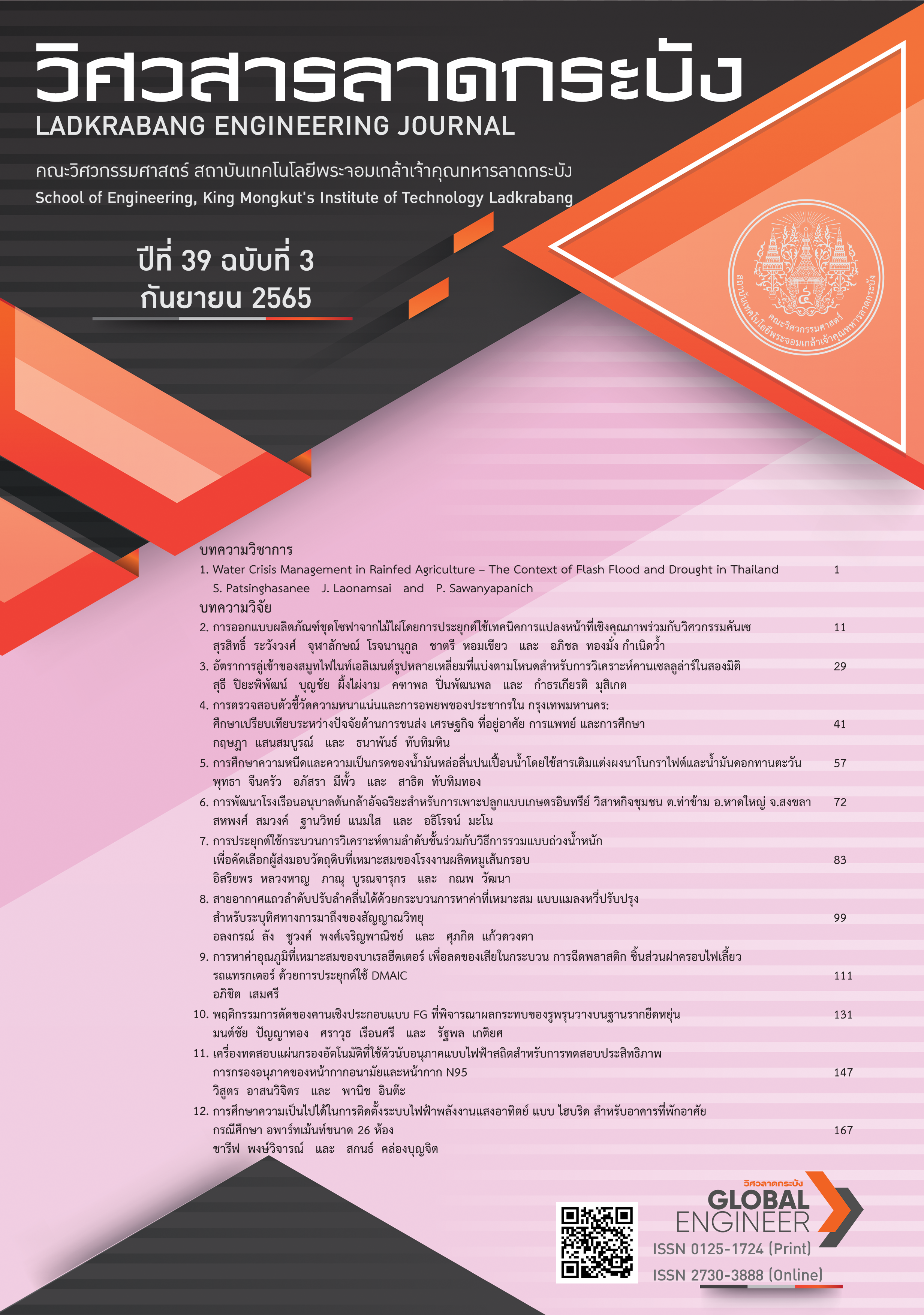พฤติกรรมการดัดของคานเชิงประกอบแบบ FG ที่พิจารณาผลกระทบของรูพรุนวางบนฐานรากยืดหยุ่น
คำสำคัญ:
วัสดุเชิงประกอบแบบ FGMs, คานเชิงประกอบแบบ FG, วัสดุรูพรุน, พฤติกรรมการดัด, ฐานรากยืดหยุ่นบทคัดย่อ
บทความนี้มีวัตถุประสงค์เพื่อนำเสนอแบบจำลองในศึกษาพฤติกรรมการดัดของคานเชิงประกอบแบบ FG วางบนฐานรากยืดหยุ่นและพิจารณาถึงผลกระทบจากรูพรุนของวัสดุ ลักษณะการเปลี่ยนแปลงของค่าโมดูลัสยืดหยุ่นตามความหนากำหนดให้เป็นไปตามกฎกำลังและรวมผลกระทบจากรูพรุน จากนั้นใช้ทฤษฎีคานของออยเลอร์–เบอร์นูลลีเพื่ออธิบายพฤติกรรมการดัดของคาน สำหรับสมการควบคุมของปัญหาได้พัฒนาขึ้นจากการประยุกต์ใช้หลักการของงานเสมือน ในขณะที่คำตอบของปัญหาสร้างขึ้นจากวิธีเชิงวิเคราะห์และได้เปรียบเทียบผลการคำนวณที่ได้กับคำตอบจากวิธีกาเลอร์คินไฟไนต์เอลิเมนต์เพื่อประเมินความถูกต้องของคำตอบ จากการศึกษาพบว่า 1) การเพิ่มขึ้นของสัมประสิทธิ์ความพรุนทำให้ค่าโมดูลัสยืดหยุ่นมีค่าที่ลดลง 2) การเพิ่มขึ้นของสัมประสิทธิ์ความพรุนและดัชนีเลขยกกำลังจะทำให้ตำแหน่งของแกนสะเทินเลื่อนสูงขึ้น อีกทั้งยังทำให้ความแข็งแกร่งการดัดมีค่าที่ลดลงส่งผลให้คานเกิดการโก่งตัวที่เพิ่มขึ้น 3) ลักษณะการกระจายของความเค้นตามแนวแกน บนหน้าตัดจะขึ้นอยู่กับค่าสัมประสิทธิ์ความพรุนและดัชนีเลขยกกำลัง 4) ฐานรากยืดหยุ่นมีอิทธิพลต่อคานที่มีความพรุนสูงมากกว่าคานที่มีความพรุนต่ำ
References
R. M. Mahamood and E. T. Akinlabi, “Introduction to Functionally Graded Materials,” in Functionally graded materials,” Cham, Switzerland: Springer, 2017, ch. 1, sec. 1, pp. 1–2.
I. Elishakoff, D. Pentaras and C. Gentilini, “Introduction to Functionally Graded Materials,” in Mechanics of functionally graded material structures, Toh Tuck Link, Singapore: World Scientific, 2015, ch. 2, pp. 13–14.
B. Saleh, J. Jiang, R. Fathi, T. Al-hababi, Q. Xu, L. Wang, D. Song and A. Ma, “30 Years of Functionally Graded Materials: An Overview of Manufacturing Methods, Applications and Future Challenges,” Composite Part B, vol. 201, 2020, Art.no. 108376, doi:10.1016/j.compositesb.2020.108376.
J. Zhu, Z. Lai, Z. Yin, J. Jeon and S. Lee, “Fabrication of ZrO2–NiCr Functionally Graded Material by Powder Metallurgy,” Materials Chemistry and Physics, vol. 68, no. 1–3, pp. 130–135, 2001, doi: 10.1016/S0254-0584(00)00355-2.
N. Wattanasakulpong, B. G. Prusty, D. W. Kelly and M. Hoffman, “Free Vibration Analysis of Layered Functionally Graded Beams with Experimental Validation,” Materials and Design, vol. 36, pp. 182–190, 2012, doi: 10.1016/j.matdes.2011.10.049.
K. E. Harti, M. Rahmoune, M. Sanbi, R. Saadani, M. Bentaleb and M. Rahmoune, “Finite Element Model of Vibration Control for an Exponential Functionally Graded Timoshenko Beam with Distributed Piezoelectric Sensor/Actuator,” actuators, vol. 8, no. 1, 2019, Art.no. 19, doi: 10.3390/act8010019.
P. R. Kumar, K. M. Rao and N. M. Rao, “Effect of Taper on Free Vibration of Functionally Graded Rotating Beam by Mori-Tanaka Method,” Journal of The Institution of Engineers (India): Series C, vol. 100, pp. 729–736, 2019, doi: 10.1007/s40032-018-0477-z.
R. Singh and P. Sharma, “A Review on Modal Characteristics of FGM Structures,” AIP Conference Proceedings, vol. 2148, no. 1, 2019, Art.no. 030037, doi: 10.1063/1.5123959.
S. C. Mohanty, R. R. Dash and T. Rout, “Parametric Instability of a Functionally Graded Timoshenko Beam on Winkler’s Elastic Foundation,” Nuclear Engineering and Design, vol. 241, no. 8, pp. 2698–2715, 2011, doi: 10.1016/j.nucengdes.2011.05.040.
S. C. Mohanty, R. R. Dash and T. Rout, “Static and Dynamic Analysis of a Functionally Graded Timoshenko Beam on Winkler’s Elastic Foundation,” Journal of Engineering Research and Studies, vol. 1, no.2, pp. 149–165, 2010.
N. D. Nguyen, T. P. Vo and T. -K. Nguyen, “An Improved Shear Deformation Theory for Bending and Buckling Response of Thin-walled FG Sandwich I-beams Resting on the Elastic Foundation,” Composite Structures, vol. 254, 2020, Art.no. 112823, doi: 10.1016/j.compstruct.2020.112823.
N. Fouda, T. El-midany and A.M. Sadoun, “Bending, Buckling and Vibration of a Functionally Graded Porous Beam Using Finite Elements,” Journal of Applied and Computational Mechanics, vol. 3, no. 4, pp. 274–282, 2017, doi:10.22055/JACM.2017.21924.1121.
K. Gao, R. Li and J. Yang, “Dynamic Characteristics of Functionally Graded Porous Beams with Interval Material Properties,” Engineering Structures, vol. 197, 2019, Art.no. 109441, doi: 10.1016/j.engstruct.2019.109441.
M. Fouaidi, M. Jamal and N. Belouaggadia, “Nonlinear Bending Analysis of Functionally Graded Porous Beams Using the Multiquadric Radial Basis Functions and a Taylor Series-Based Continuation Procedure,” Composite Structures, vol. 252, 2020, Art.no. 112593, doi: 10.1016/j.compstruct.2020.112593.
N. T. B. Phuong, T. M. Tu, H. T. Phuong and N. V. Long, “Bending Analysis of Functionally Graded Beam with Porosities Resting on Elastic Foundation Based on Neutral Surface Position,” Journal of Science and Technology in Civil Engineering, vol. 13, no. 1, pp. 33–45, 2019, doi: 10.31814/stce.nuce2019-13(1)-04.
R. Penna and L. Feo, “Nonlinear Dynamic Behavior of Porous and Imperfect Bernoulli-Euler Functionally Graded Nanobeams Resting on Winkler Elastic Foundation,” technologies, vol. 8, no. 4, 2020, Art.no. 56, doi: 10.3390/technologies8040056.
N. D. Nguyen, T. N. Nguyen, T. K. Nguyen and T. P. Vo, “A new two-variable shear deformation theory for bending, free vibration and buckling analysis of functionally graded porous beams,” Composite Structures, vol. 282, 2022, Art.no. 115095, doi:10.1016/j.compstruct.2021.115095.
V. Boggarapu, R. Gujjala, S. Ojha, S. Acharya, P.V. Babu, S. Chowdary, D. K. Gara, “State of the Art in Functionally Graded Materials,” Composite Structures, vol. 262, 2021, Art.no. 1113596, doi: 10.1016/j.compstruct.2021.113596.
M. Dhuria, N. Grover and K. Goyal, “Influence of Porosity Distribution no Static and Buckling Responses of Porous Functionally Graded Plates,” Structures, vol. 34, pp. 1458–1474, 2021, doi: 10.1016/j.istruc.2021.08.050.
G. Udupa, S.S. Rao and K.V. Gangadharan, “Functionally Graded Composite Materials: An Overview,” Procedia Materials Science, vol. 5, pp. 1291–1299, 2014, doi: 10.1016/j.mspro.2014.07.442.
D. Gayen, R. Tiwari and D. Chakraborty, “Static and Dynamic analyses of Cracked Functionally Graded Structural Components: A Review,” Composites Part B, vol. 173, 2019, Art.no. 106982, doi: 10.1016/j.compositesb.2019.106982.
Downloads
เผยแพร่แล้ว
How to Cite
ฉบับ
บท
License
Copyright (c) 2022 คณะวิศวกรรมศาสตร์ สถาบันเทคโนโลยีพระจอมเกล้าเจ้าคุณทหาร

This work is licensed under a Creative Commons Attribution-NonCommercial-NoDerivatives 4.0 International License.
บทความที่ได้รับการตีพิมพ์เป็นลิขสิทธิ์ของคณะวิศวกรรมศาสตร์ สถาบันเทคโนโลยีพระจอมเกล้าเจ้าคุณทหารลาดกระบัง
ข้อความที่ปรากฏในบทความแต่ละเรื่องในวารสารวิชาการเล่มนี้เป็นความคิดเห็นส่วนตัวของผู้เขียนแต่ละท่านไม่เกี่ยวข้องกับสถาบันเทคโนโลยีพระจอมเกล้าเจ้าคุณทหารลาดกระบัง และคณาจารย์ท่านอื่นๆในสถาบันฯ แต่อย่างใด ความรับผิดชอบองค์ประกอบทั้งหมดของบทความแต่ละเรื่องเป็นของผู้เขียนแต่ละท่าน หากมีความผิดพลาดใดๆ ผู้เขียนแต่ละท่านจะรับผิดชอบบทความของตนเองแต่ผู้เดียว






